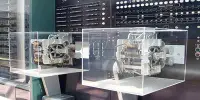Hydrothermal vents appear to be the least habitable habitat on Earth. These volcanic leaks erupt boiling hot water so densely packed with particles and metals that it resembles black smoke billowing from a chimney in the deep sea’s permanent darkness, cold, and merciless pressures. Even in these horrific environments, though, life abounds, with everything from enormous clams and hungry crabs to spindly octopuses and ghostly eelpout fish.
And those are only the animals that lurk above the vents. Researchers recently flipped over slabs of the seafloor using a deep-sea remotely operated vehicle (ROV) to find a hidden biosphere teeming with small life beneath the vents themselves. The variety of worms, snails, minuscule larvae, and bacteria that live down here, according to Monika Bright, a zoologist at the University of Vienna in Austria who led the expedition, adds a new layer of complexity to hydrothermal vent ecosystems, which scientists have studied since 1977.
“We’ve known about the vents above for a long time, but this is basically a completely new ecosystem below,” Bright explains. “It’s especially strange that we discovered it in such a well-studied location.”

Bright and a global team of partners aboard the nonprofit Schmidt Ocean Institute’s research vessel Falkor (too) in Panama last month. The researchers investigated species ranging from symbiotic bacteria in deep-sea clams to the temperature limits of small copepod crustaceans off the Pacific coast of Central America.
The team centered its ROV dives on the East Pacific Rise, a line of deep-sea volcanoes formed by diverging tectonic plates. Magma surges up from the rift and cools to form a fresh sea floor as the plates drift apart.
Hydrothermal vents are fueled by these dynamic conditions. Water percolates through fissures in the splintering marine crust and collides with scorching lava beneath. When seawater is heated to 400 °C, chemical reactions produce a supercharged fluid rich in compounds such as sulfur, which spews out of openings in the ocean floor.
Because bacteria transform chemicals into energy-producing carbohydrates, these geyser-like vents are hotspots of deep-sea diversity that can flourish in the dark. Some of these bacteria can be found inside the lengthy bodies of giant tube worms (Riftia pachyptila). These worms, whose exposed bright-red, feathery gills give them the appearance of two-meter-long lipstick tubes, grow in dense patches around vents and serve as a home for other vent dwellers.
When volcanic activity in the area changes due to eruptions or earthquakes, these tenacious worm fortresses are destroyed. When new hydrothermal vents appear dozens or even hundreds of kilometers away, towering thickets of enormous tube worms populate them within a few years.
Bright says it’s unclear how these worms get to new vents and establish themselves. Few tube worm larvae have been seen in the water column surrounding vents, and a steady stream of supercharged fluid would make it impossible for the larvae to attach themselves from above. The researchers hypothesized that tube worm larvae wiggle through fissures beneath the seafloor in search of new vents.
To put this theory to the test, the scientists deployed the ROV to the Tica Vent, a well-studied hydrothermal vent lying 2,500 meters beneath the ocean’s surface. Initially, the scientists fastened mesh cages to seafloor fractures to gather organisms that migrated between the stony floor and the deep underneath. When the boxes became too heavy, the crew took a more direct approach, tipping over big pieces of bottom with the ROV’s robotic arm to retrieve what lay beneath.
This revealed an underground labyrinth. The water was a pleasant 25 degrees Celsius in a network of caverns and fissures carved into the rock. This created the ideal environment for a robust microbial population of protists, bacteria, viruses, and even larger organisms like snails and worms.
While the crew is the first to peer below the seafloor around these hydrothermal occurrences, Julie Huber, a geochemist at Woods Hole Oceanographic Institution in Massachusetts who was not part of the mission, says the result is not wholly surprising. She observes that the marine crust at midocean ridges is porous, providing ample space for fluids, nutrients, and bacteria. “Given that most animals at hydrothermal vents require all three of these things to thrive, I suppose it makes sense that animals are carving out another niche to attach themselves to and make a living,” adds Huber. She also believes that living beneath the seafloor may keep these little creatures secure from marauding deep-sea crabs.
The researchers uncovered a plethora of tiny tubes beneath the vents, revealing that these below chambers act as tube worm nurseries. The scientists believe that tube worm larvae navigate this subsurface maze, which Huber refers to as the “subseafloor conveyor belt,” to get from one vent to the next. The tube worms live down there at first before rising up near the vents as they develop up to 85 centimeters every year.
However, many mysteries surround the world underneath hydrothermal vents. Bright and her colleagues intend to sequence the DNA of animals and bacteria collected both above and below the bottom in order to investigate how these two ecosystems are linked. “As a scientist, you discover something, and then you have ten more questions,” Bright explains.
Bright and her colleagues believe that by shining greater light on the inner workings of hydrothermal vent ecosystems, they will be able to protect them from development. Because of the minerals that leach out of the magma-heated water that gushes from the vents, these places could be of interest to deep-sea mining businesses.
That commercial motivation might jeopardize one of the world’s most unique habitats, a place that Bright says scientists are still trying to understand. “From our point of view, these vents are very extreme and exotic,” she explains. “However, for the animals, living at these pressures with fluctuating temperatures and chemistry is not extreme—it’s normal.”
















